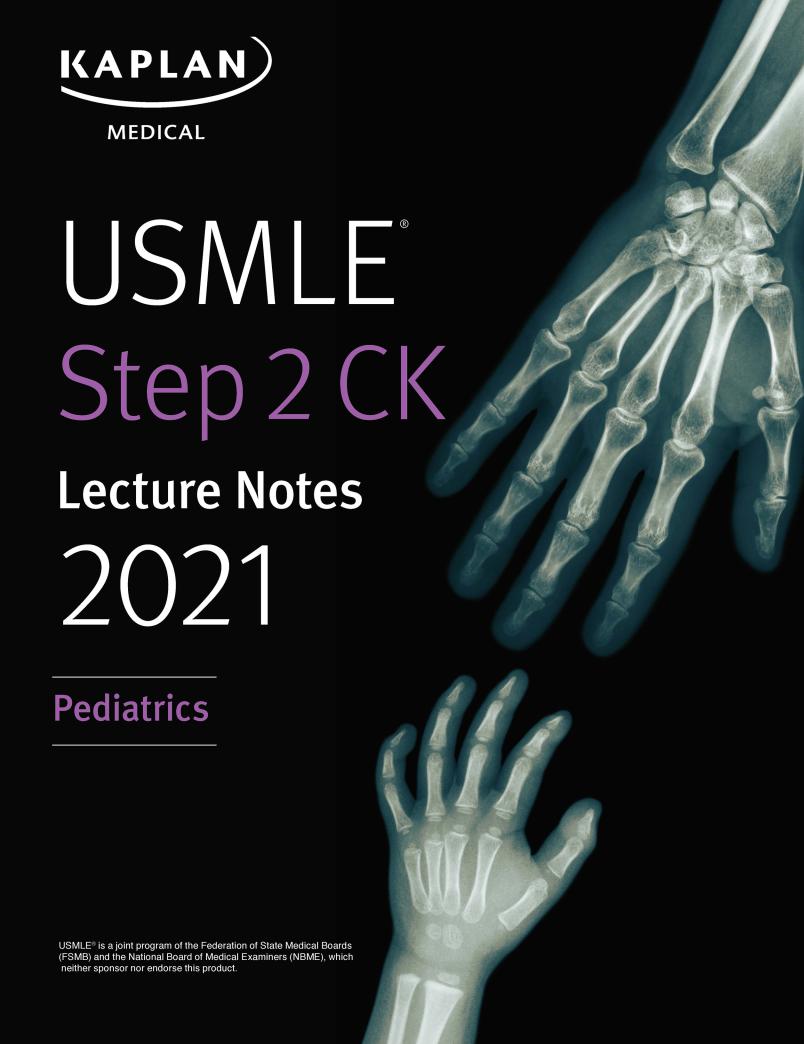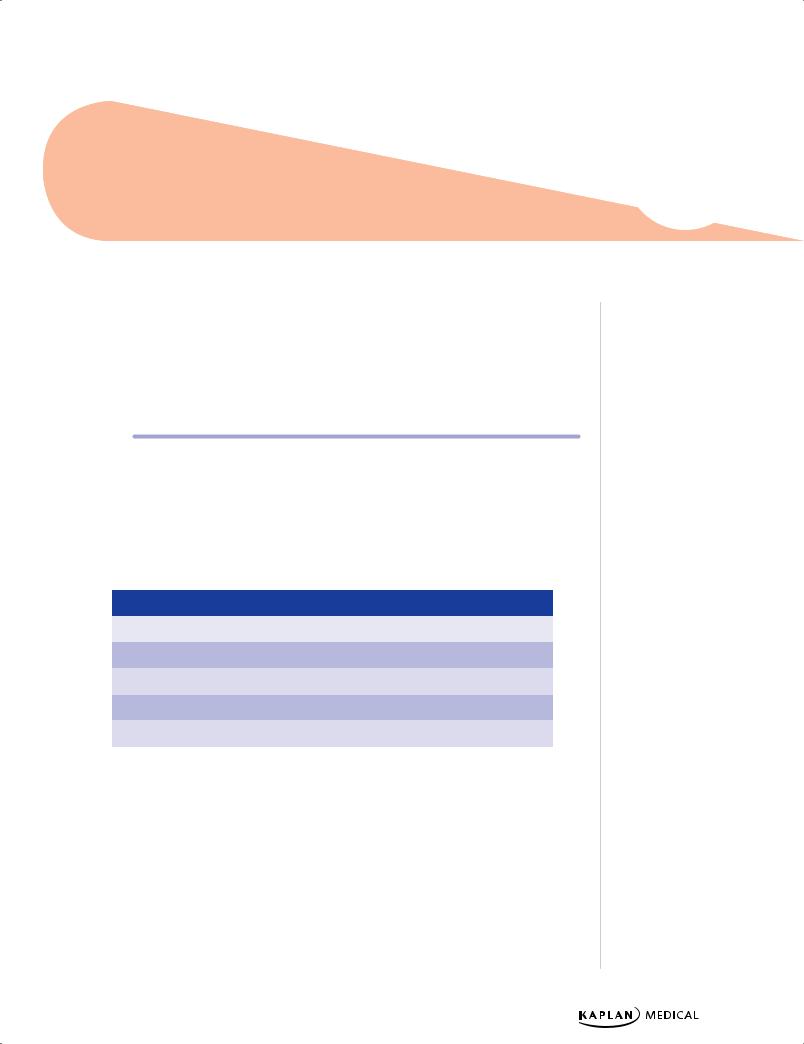
Полезные материалы за все 6 курсов / Учебники, методички, pdf / Kaplan Pediatrics USMLE 2CK 2021
.pdf

USMLE®
Step 2 CK
Lecture Notes
2021
Pediatrics
Published by dr-notes.com

USMLE® is a joint program of the Federation of State Medical Boards (FSMB) and the National Board of Medical Examiners (NBME), which neither sponsor nor endorse this product.
This publication is designed to provide accurate information in regard to the subject matter covered as of its publication date, with the understanding that knowledge and best practice constantly evolve. The publisher is not engaged in rendering medical, legal, accounting, or other professional service.
If medical or legal advice or other expert assistance is required, the services of a competent professional should be sought. This publication is not intended for use in clinical practice or the delivery of medical care. To the fullest extent of the law, neither the publisher nor the editors assume any liability for any injury and/or damage to persons or property arising out of or related to any use of the material contained in this book.
© 2020 by Kaplan, Inc.
Published by Kaplan Medical, a division of Kaplan, Inc. 750 Third Avenue
New York, NY 10017
All rights reserved. The text of this publication, or any part thereof, may not be reproduced in any manner whatsoever without written permission from the publisher.
10 9 8 7 6 5 4 3 2 1
Course ISBN: 978-1-5062-6147-8
Course Kit ISBN: 978-1-5062-6135-5
Retail ISBN: 978-1-5062-6145-4
Retail Kit ISBN: 978-1-5062-6137-9
Kit items come as a set and should not be broken out and sold separately.
Kaplan Publishing print books are available at special quantity discounts to use for sales promotions, employee premiums, or educational purposes. For more information or to purchase books, please call the Simon & Schuster special sales department at 866-506-1949.

Editors
William G. Cvetnic, MD, MBA
Fellow of the American Academy of Pediatrics
Board Certified in Pediatrics and Neonatal-Perinatal Medicine
Jacksonville, Florida
Eduardo Pino, MD
Associate Professor, Department of Pediatrics
Marshall University School of Medicine
Medical Director, Hoops Family Children’s Hospital
Cabell Huntington Hospital
Huntington, West Virginia
Published by dr-notes.com

We want to hear what you think. What do you like or not like about the Notes? Please email us at medfeedback@kaplan.com.

Table of Contents |
00 |
Chapter Title |
Chapter 1: The Newborn . . . . . . . . . . . . . . . . . . . . . . . |
. . . . . . . . . . . . . . . . . . . . |
. . |
. |
|
. . 1 |
|
Chapter 2: Genetics/Dysmorphology . . . . . . . . . . . . . |
. . . . . . . . . . . . . . . . . . . . |
. . |
. |
|
. 21 |
|
Chapter 3: Growth and Nutrition . . . . . . . . . . . . . . . . |
. . . . . . . . . . . . . . . . . . . . |
. . |
. |
|
. 31 |
|
Chapter 4: Development . . . . . . . . . . . . . . . . . . . . . . . |
. . . . . . . . . . . . . . . . . . . . |
. . |
. |
|
. 43 |
|
Chapter 5: Behavioral/Psychological Disorders . . . . . |
. . . . . . . . . . . . . . . . . . . . |
. . |
. |
|
. 49 |
|
Chapter 6: Immunizations . . . . . . . . . . . . . . . . . . . . . . |
. . . . . . . . . . . . . . . . . . . . |
. . |
. |
|
. 53 |
|
Chapter 7: Child Abuse and Neglect . . . . . . . . . . |
. . . . . . . . . . . . . . . . |
. . |
|
. |
.61. . . . . . . |
|
Chapter 8: Respiratory |
Disease . . . . . . . . . . . |
. . . . . . . . . . . . . . |
. |
. |
. |
67. . . . . . . . . . . . . |
Chapter 9: Allergy and |
Asthma . . . . . . . . . . . |
. . . . . . . . . . . . . . |
. |
. |
. |
81. . . . . . . . . . . . . |
Chapter 10: Immune-Mediated Disease . . . . . . . . . . . |
. . . . . . . . . . . . . . . . . . . . |
. . |
. |
|
. 91 |
|
Chapter 11: Disorders of the Eye .. .. .. .. .. .. .. .. .. .. .. .. .. .. .. .. |
.. .. .. .. .. .. .. .. .. .. .. .. .. .. .. .. .. .. .. .. |
.. .. |
.. |
.. |
99 |
|
Chapter 12: Disorders of the Ear, Nose, and Throat . |
. . . . . . . . . . . . . . . . . . . . |
. . |
. |
105 |
||
Chapter 13: Cardiology |
. . . . . . . . . . . . . . . . . . . . . . . . |
. . . . . . . . . . . . . . . . . . . . |
. . |
. |
|
113 |
Chapter 14: Gastrointestinal Disease . . . . . . . . . . . . . |
. . . . . . . . . . . . . . . . . . . . |
. . |
. |
139 |
||
Chapter 15: Renal and Urologic Disorders . . . . . . |
. . . . . . . . . . . . . . |
. . |
. 155. . . . . . . . |
|||
Chapter 16: Endocrine Disorders .. .. .. .. .. .. .. .. .. .. .. .. .. .. .. .. |
.. .. .. .. .. .. .. .. .. .. .. .. .. .. .. .. .. .. .. .. |
.. .. |
.. |
|
167 |
|
Chapter 17: Orthopedic Disorders . . . . . . . . . . . . . . |
. . . . . . . . . . . . . . . . . . |
. . |
. |
|
179. . . |
|
Published by dr-notes.com
v

USMLE Step 2 CK λ Pediatrics
Chapter 18: Rheumatic and Vasculitic Disorders . . . . . . . . . . . . . . . . . . . . . . . . . . . 187
Chapter 19: Hematology . . . . . . . . . . . . . . . . . . . . . . . . . . . . . . . . . . . . . . . . . . . . . . 197
Chapter 20: Oncology . . . . . . . . . . . . . . . . . . . . . . . . . . . . . . . . . . . . . . . . . . . . . . . . 213
Chapter 21: Neurology . . . . . . . . . . . |
. . . . . . . . . . . . . |
. |
. . . . . . . . . . . . |
|
. 219. . . . . . . . . |
Chapter 22: Infectious Disease . . . . . . . . |
. . . . . . . . . . . . . . . . |
. |
. . . . . . . . . . . . . . . |
. |
237 |
Chapter 23: Adolescence . . . . . . . . |
. . . . . . . . . . . |
. |
. . . . . . . . . . |
. |
261. . . . . . . . . . . . |
Index . . . . . . . . . . . . . . . . . . . . . . |
. . . . . . . . . . |
. |
. . . . . . . . . |
. |
267. . . . . . . . . . . |
Additional resources available at kaptest.com/usmlebookresources
vi

The Newborn |
1 |
Chapter Title |
Learning Objectives
Calculate an Apgar score
Use knowledge of birth injuries to predict symptomology
Demonstrate understanding of newborn screening, fetal growth/maturity, and neonatal infections
APGAR SCORE
A newborn infant at birth is noted to have acrocyanosis, heart rate 140/min, and grimaces to stimulation. She is active and has a lusty cry. What is her Apgar score?
Table 1-1. Apgar Scoring System
|
Evaluation |
|
|
0 Points |
|
|
1 Point |
|
|
2 Points |
|
|
|
|
|
|
|
|
|
|
|
|
|
Heart rate |
0 |
|
<100/min |
|
>100/min |
||||||
|
|
|
|
|
|
|
|
|
|
|
|
Respiration |
None |
Irregular, shallow, gasps |
|
Crying |
|||||||
|
|
|
|
|
|
|
|
|
|
|
|
Color |
Blue |
Pale, blue extremities |
|
Pink |
|||||||
|
|
|
|
|
|
|
|
|
|
|
|
Tone |
None |
Weak, passive |
|
Active |
|||||||
|
|
|
|
|
|
|
|
|
|
|
|
Reflex irritability |
None |
Facial grimace |
|
Active withdrawal |
|||||||
|
|
|
|
|
|
|
|
|
|
|
|
Apgar scores are routinely assessed at 1 and 5 minutes, and every 5 minutes thereafter as long as resuscitation is continuing.
•The 1-minute score gives an idea of what was going on during labor and delivery.
•The 5-minute score gives an idea of response to therapy (resuscitation).
In general, the Apgar score is not predictive of outcome; however, infants with score 0−3 at ≥5 minutes compared to infants with score 7−10 have a worse neurologic outcome.
Published by dr-notes.com |
1 |
|
|
|
|

USMLE Step 2 CK λ Pediatrics
Newborn Care
•Vitamin K IM
•Prophylactic eye erythromycin
•Umbilical cord care
•Hearing test
•Newborn screening tests
BIRTH INJURIES
On physical exam, a 12-hour-old newborn is noted to have nontender swelling of the head that does not cross the suture line. What is the most likely diagnosis?
Table 1-2. Common Injuries During Deliveries
|
Injury |
|
|
Specifics |
|
|
Outcome |
|
|
|
|
|
|
|
|
|
|
Skull fractures |
In utero from pressure against bones or |
• Linear: no symptoms and no treatment needed |
||||||
|
|
|
forceps; linear: most common |
• Depressed: elevate to prevent cortical injury |
||||
|
|
|
|
|
|
|||
|
|
|
|
|
|
|
|
|
|
Brachial palsy |
|
Erb-Duchenne: C5–C6; cannot abduct |
|
Most with full recovery (months); depends on |
|||
|
|
|
|
shoulder; externally rotate and supinate |
|
whether nerve was injured or lacerated; Rx: proper |
||
|
|
|
|
forearm; Klumpke: C7–C8 ± T1; paralyzed |
|
positioning and partial immobilization; massage |
||
|
|
|
|
hand ± Horner syndrome |
|
and range of motion exercises; if no recovery in |
||
|
|
|
|
|
|
|
3–6 mo, then neuroplasty |
|
|
|
|
|
|
|
|
|
|
|
Clavicular fracture |
|
Especially with shoulder dystocia in vertex |
|
Palpable callus within a week; Rx: with |
|||
|
|
|
|
position and arm extension in breech |
|
immobilization of arm and shoulder |
||
|
|
|
|
|
|
|
|
|
|
Facial nerve palsy |
|
Entire side of face with forehead; forceps |
|
Improvement over weeks (as long as fibers were |
|||
|
|
|
|
delivery or in utero pressure over facial nerve |
|
not torn); need eye care; neuroplasty if no |
||
|
|
|
|
|
|
|
improvement (torn fibers) |
|
|
|
|
|
|
|
|
|
|
|
Caput succedaneum |
|
Diffuse edematous swelling of soft tissues of |
|
Disappears in first few days; may lead to molding |
|||
|
|
|
|
scalp; crosses suture lines |
|
for weeks |
||
|
|
|
|
|
|
|
|
|
|
Cephalohematoma |
|
Subperiosteal hemorrhage: does not cross |
|
May have underlying linear fracture; resolve in 2 wk |
|||
|
|
|
|
suture lines |
|
to 3 mo; may calcify; jaundice |
||
|
|
|
|
|
|
|
|
|
2

Chapter 1 λ The Newborn
PHYSICAL EXAMINATION
A newborn infant has a blue-gray pigmented lesion on the sacral area. It is clearly demarcated and does not fade into the surrounding skin. What is the most likely diagnosis?
A newborn has a flat, salmon-colored lesion on the glabella, which becomes darker red when he cries. What is the best course of management?
Table 1-3. Physical Examination—Common Findings
|
Finding/Diagnosis |
|
|
Description/Comments |
|
|
|
|
|
|
|
|
Skin |
|
|
|
|
|
Cutis marmorata |
|
Lacy, reticulated vascular pattern over most of body when baby is cooled; improves over first |
||
|
|
|
|
month; abnormal if persists |
|
|
Salmon patch |
|
Pale, pink vascular macules; found in nuchal area, glabella, eyelids; usually disappears |
||
|
(nevus simplex) |
|
|
|
|
|
Mongolian spots |
|
Blue to slate-gray macules; seen on presacral, back, posterior thighs; > in nonwhite infants; |
||
|
|
|
|
arrested melanocytes; usually fade over first few years; differential: child abuse |
|
|
Erythema toxicum, |
|
Firm, yellow-white papules/pustules with erythematous base; peaks on second day of life; contain |
||
|
neonatorum |
|
eosinophils; benign |
||
|
Hemangioma |
|
Superficial: bright red, protuberant, sharply demarcated; most often appear in first 2 months; |
||
|
|
|
|
most on face, scalp, back, anterior chest; rapid expansion, then stationary, then involution (most |
|
|
|
|
|
by 5–9 years of age); Rx: beta blockers, embolization; deeper: bluish hue, firm, cystic, less likely |
|
|
|
|
|
to regress; Rx: (steroids, pulsed laser) only if large and interfering with function |
|
|
|
|
|
|
|
|
Head |
|
|
|
|
|
Preauricular |
|
Look for hearing loss and genitourinary anomalies. |
||
|
tags/pits |
|
|
|
|
|
Coloboma of iris |
|
Cleft of lid, iris, lens, retina, or choroid. In iris, manifests as keyhole appearance at the 6 o’clock |
||
|
|
|
|
position. May be autosomal-dominant or part of CHARGE syndrome. |
|
|
Leukocoria—white |
|
Retinoblastoma; cataract; retinopathy of prematurity; retinal detachment; larval granulomatosis |
||
|
reflex |
|
|
|
|
|
Aniridia |
|
Hypoplasia of iris; defect may go through to retina; association with Wilms tumor |
||
|
|
|
|
|
|
|
Extremities |
|
|
|
|
|
Polydactyly |
|
Extra digit, partial digit, or cleft digit after the 4th finger (ulnar side); world’s most common minor |
||
|
|
|
|
malformation; usually surgically removed at 1–2 years of age |
|
|
|
|
|
|
|
Published by dr-notes.com |
3 |
|
|
|
|
